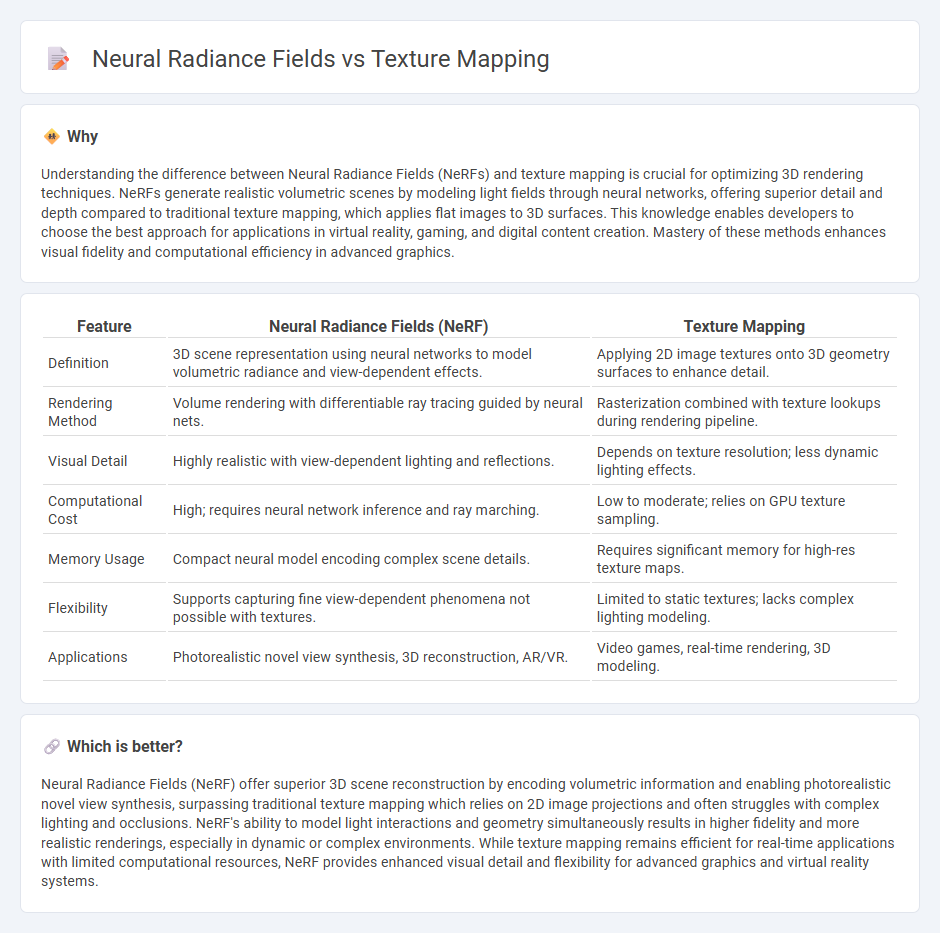
Neural Radiance Fields (NeRF) represent a cutting-edge approach to 3D scene reconstruction by encoding volumetric density and color as continuous functions, enabling highly realistic rendering from sparse input images. Texture mapping, a traditional graphics technique, applies 2D image textures onto 3D surface models to simulate detailed appearances without volumetric depth information. Explore how advancements in neural rendering outperform conventional texture mapping in photorealism and scene understanding.
Why it is important
Understanding the difference between Neural Radiance Fields (NeRFs) and texture mapping is crucial for optimizing 3D rendering techniques. NeRFs generate realistic volumetric scenes by modeling light fields through neural networks, offering superior detail and depth compared to traditional texture mapping, which applies flat images to 3D surfaces. This knowledge enables developers to choose the best approach for applications in virtual reality, gaming, and digital content creation. Mastery of these methods enhances visual fidelity and computational efficiency in advanced graphics.
Comparison Table
| Feature | Neural Radiance Fields (NeRF) | Texture Mapping |
|---|---|---|
| Definition | 3D scene representation using neural networks to model volumetric radiance and view-dependent effects. | Applying 2D image textures onto 3D geometry surfaces to enhance detail. |
| Rendering Method | Volume rendering with differentiable ray tracing guided by neural nets. | Rasterization combined with texture lookups during rendering pipeline. |
| Visual Detail | Highly realistic with view-dependent lighting and reflections. | Depends on texture resolution; less dynamic lighting effects. |
| Computational Cost | High; requires neural network inference and ray marching. | Low to moderate; relies on GPU texture sampling. |
| Memory Usage | Compact neural model encoding complex scene details. | Requires significant memory for high-res texture maps. |
| Flexibility | Supports capturing fine view-dependent phenomena not possible with textures. | Limited to static textures; lacks complex lighting modeling. |
| Applications | Photorealistic novel view synthesis, 3D reconstruction, AR/VR. | Video games, real-time rendering, 3D modeling. |
Which is better?
Neural Radiance Fields (NeRF) offer superior 3D scene reconstruction by encoding volumetric information and enabling photorealistic novel view synthesis, surpassing traditional texture mapping which relies on 2D image projections and often struggles with complex lighting and occlusions. NeRF's ability to model light interactions and geometry simultaneously results in higher fidelity and more realistic renderings, especially in dynamic or complex environments. While texture mapping remains efficient for real-time applications with limited computational resources, NeRF provides enhanced visual detail and flexibility for advanced graphics and virtual reality systems.
Connection
Neural radiance fields (NeRFs) generate 3D scenes by modeling light emission and volume density at every point in space, enabling photorealistic rendering from new viewpoints. Texture mapping complements NeRFs by applying detailed surface appearance information onto the reconstructed geometry, enhancing visual realism. Integrating texture mapping with neural radiance fields improves scene fidelity by combining volumetric light representations with high-resolution surface details.
Key Terms
UV Mapping
Texture mapping relies on UV mapping to project 2D images onto 3D models, providing detailed surface appearance by assigning texture coordinates to each vertex. Neural Radiance Fields (NeRF) bypass traditional UV mapping by using volumetric scene representation, enabling photorealistic rendering from multiple viewpoints without explicit texture coordinates. Explore how UV mapping and NeRF differ fundamentally in rendering workflows and applications by diving deeper into their mechanisms.
Volumetric Rendering
Texture mapping enhances 3D models by projecting 2D images onto surfaces to simulate detail and color, while neural radiance fields (NeRFs) represent volumetric scenes through continuous volumetric rendering, capturing intricate light interactions within a volume. NeRFs produce highly realistic renderings by optimizing a neural network to model scene radiance as a function of spatial coordinates and viewing directions, surpassing traditional texture mapping in rendering complex volumetric effects like translucency and occlusion. Explore the advancements in volumetric rendering by diving deeper into the contrasting capabilities of texture mapping and neural radiance fields.
Scene Representation
Texture mapping uses 2D images applied onto 3D geometry to represent a scene's surface appearance efficiently but struggles with complex view-dependent effects. Neural Radiance Fields (NeRFs) represent scenes as continuous volumetric radiance and density functions, enabling realistic view synthesis with fine details and accurate light interaction. Explore more about how these methods impact rendering quality and computational demands.
Source and External Links
Ultimate Guide to Texture Mapping for Beginners - Texture mapping adds realism by applying detailed surface textures to 3D models using methods like photography, painting, and image editing, with techniques including multitexturing and UV wrapping to map images onto model surfaces.
Texture Mapping - Texture mapping applies various types such as diffuse, normal, specular, bump, displacement, and emissive mapping to simulate complex surface appearances and lighting effects on 3D models.
Introduction to Texturing - Texture mapping is a shading technique that projects 2D images (textures) onto 3D objects to add detailed surface color and patterns with minimal computational cost, fundamentally enhancing realism in rendering.
 dowidth.com
dowidth.com